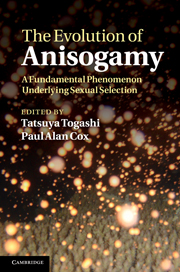Book contents
- Frontmatter
- Contents
- Contributors
- Introduction: The evolutionary mystery of gamete dimorphism
- 1 The origin and maintenance of two sexes (anisogamy), and their gamete sizes by gamete competition
- 2 The evolutionary instability of isogamy
- 3 Contact, not conflict, causes the evolution of anisogamy
- 4 Nucleo-cytoplasmic conflict and the evolution of gamete dimorphism
- 5 Adaptive significance of egg size variation of aquatic organisms in relation to mesoscale features of aquatic environments
- 6 Gamete encounters
- 7 Evolution of anisogamy and related phenomena in marine green algae
- Index
- References
2 - The evolutionary instability of isogamy
Published online by Cambridge University Press: 19 May 2011
- Frontmatter
- Contents
- Contributors
- Introduction: The evolutionary mystery of gamete dimorphism
- 1 The origin and maintenance of two sexes (anisogamy), and their gamete sizes by gamete competition
- 2 The evolutionary instability of isogamy
- 3 Contact, not conflict, causes the evolution of anisogamy
- 4 Nucleo-cytoplasmic conflict and the evolution of gamete dimorphism
- 5 Adaptive significance of egg size variation of aquatic organisms in relation to mesoscale features of aquatic environments
- 6 Gamete encounters
- 7 Evolution of anisogamy and related phenomena in marine green algae
- Index
- References
Summary
INTRODUCTION
Multicellular organisms are usually anisogamous with different mean sizes of gametes of different sexes or mating types. It is generally believed that isogamy (equal gamete sizes of different mating types) is the most primitive mating system (e.g. Maynard Smith, 1978; 1982; Hoekstra, 1987; Maynard Smith and Szathmáry, 1995). Although we observe many isogamous species in algae, fungi, and protozoans (for review see Bell, 1982; Hoekstra, 1987), anisogamy has a much wider taxonomic distribution. Attempts to use evolutionary theory to understand this restricted distribution have met with limited success, as have attempts to understand the distribution of isogamy within groups that include both isogamous and anisogamous species, as observed in the freshwater green algal order Volvocales (Randerson and Hurst, 2001). However, there are numerous exceptions to fully accept the synthetic theory (Bell, 1978; Hoekstra, 1987). We use a series of mathematical models to help understand what might account for the comparative scarcity of isogamy. The models also produce some new hypotheses that may help explain some of the anomalies in the comparative data.
It is generally believed that the evolution of mating types preceded the evolution of gamete size dimorphism (Hoekstra, 1987; Maynard Smith and Szathmáry, 1995). For example, Hoekstra (1982, 1987) has proposed several possible mechanisms for the evolution of mating types in a randomly mating population. In the simplest mechanism, it is assumed that gamete adhesion was initially brought about by two complementary molecules.
- Type
- Chapter
- Information
- The Evolution of AnisogamyA Fundamental Phenomenon Underlying Sexual Selection, pp. 75 - 95Publisher: Cambridge University PressPrint publication year: 2011
References
- 4
- Cited by



